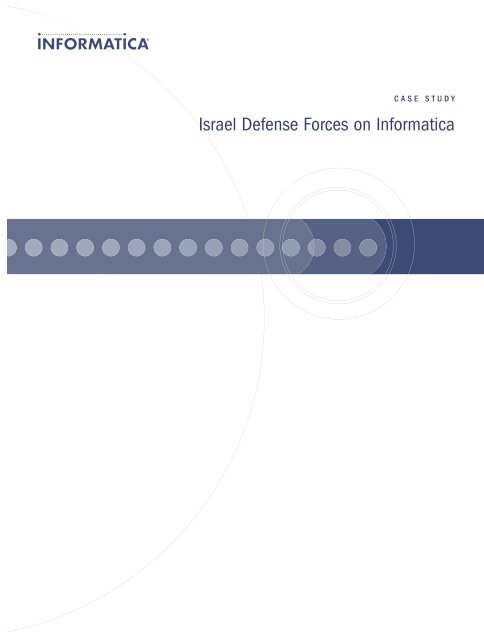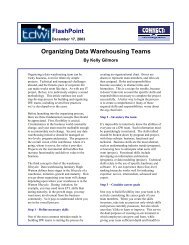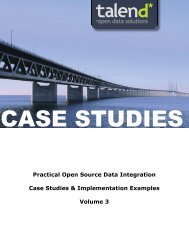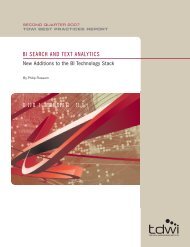Israel Defense Forces on Informatica
Israel Defense Forces on Informatica
Israel Defense Forces on Informatica
Create successful ePaper yourself
Turn your PDF publications into a flip-book with our unique Google optimized e-Paper software.
CASE STUDY<str<strong>on</strong>g>Israel</str<strong>on</strong>g> <str<strong>on</strong>g>Defense</str<strong>on</strong>g> <str<strong>on</strong>g>Forces</str<strong>on</strong>g> <strong>on</strong> <strong>Informatica</strong>
Case Study<str<strong>on</strong>g>Israel</str<strong>on</strong>g> <str<strong>on</strong>g>Defense</str<strong>on</strong>g> <str<strong>on</strong>g>Forces</str<strong>on</strong>g> <strong>on</strong> <strong>Informatica</strong>Robust Functi<strong>on</strong>ality DeliveringSignificant BenefitsAccording to Lt. Col. Yossi, PowerCenter’sease of use and robust functi<strong>on</strong>alitydelivered benefits far bey<strong>on</strong>d theexpectati<strong>on</strong>s that IDF set during its projectdesign phase. <strong>Informatica</strong> PowerCenter:• Reduced the number of man-years bya factor of five to six. The project wascompleted with 10 man-years of laborversus an estimated 60.• Decreased the project durati<strong>on</strong> fromthree years to <strong>on</strong>e.• Enabled completi<strong>on</strong> of thesignificantly-expanded project scope(all service data versus Army data<strong>on</strong>ly) within their new <strong>on</strong>e-yeartimeline and 25 percent below budget.•Supplied data quality validati<strong>on</strong> thatcleansed/standardized more than 100milli<strong>on</strong> records.• Was readily learned and adopted by20 programmers—some no older thanage 18.The storied history of the <str<strong>on</strong>g>Israel</str<strong>on</strong>g>i <str<strong>on</strong>g>Defense</str<strong>on</strong>g> <str<strong>on</strong>g>Forces</str<strong>on</strong>g> (IDF) is marked by milest<strong>on</strong>esrecognizable to even casual observers of the Middle East: The Six-day War of 1967... the Raid <strong>on</strong> Entebbe in 1976 ... the 1981 airstrike that crippled an Iraqi nuclearreactor.In 2004, the <str<strong>on</strong>g>Israel</str<strong>on</strong>g>i military achieved anothermilest<strong>on</strong>e that w<strong>on</strong>’t make the history books,but nevertheless ranks as a significantachievement that improves the IDF’s ability tomobilize forces and materiel with greaterspeed, precisi<strong>on</strong>, and efficiency.This time, the theater was not the GolanHeights or the Gaza Strip or the airport atEntebbe, Uganda. It was the datamanagement envir<strong>on</strong>ment of the IDFTechnology and Logistics Directorate—a sprawl of incompatible applicati<strong>on</strong>s thatfrustrated the Army’s efforts to manage itsequipment and resources.“We had a forest of systems throughoutLogistics,” said Lt. Col. Yossi, the Technologyand Logistics Directorate head of EnterpriseResource Planning Project Administrati<strong>on</strong>,based in Tel Aviv. “Each was a separatesystem that would speak its own language.We could do the job, but not in a fluent way.”The IDF Technology and Logistics Directorateembarked <strong>on</strong> an ambitious initiative thatwould migrate Army data from mainframe andlegacy applicati<strong>on</strong>s to a set of SAP R/3,selecting <strong>Informatica</strong>® PowerCenter® as thedata integrati<strong>on</strong> system.A first phase of the initiative aimed to migratedata from five key areas—spare parts,medical supplies, gas and oil, c<strong>on</strong>structi<strong>on</strong>materials, and office materials—to SAP R/34.7, which was running under Linux <strong>on</strong> anIBM zSeries 990 with a DB2 database.In producti<strong>on</strong> since April 2004, accessed bymany users, and affecting more Armypers<strong>on</strong>nel, the integrated SAP logisticsenvir<strong>on</strong>ment is helping the Army improvesupply chain efficiency, reduce costs, andfine-tune operati<strong>on</strong>s based <strong>on</strong> a single,c<strong>on</strong>solidated view of its data.After quickly discovering the comprehensivecapabilities of PowerCenter, the IDF hasbroadened the scope of the originalintegrati<strong>on</strong> initiative, and are now integratingdata from all service branches (Army, Navyand Air Force) using <strong>Informatica</strong>.PowerCenter: Above and Bey<strong>on</strong>dthe Call of Duty“Originally, we thought we would have toexpend 60 years of human work to performthe c<strong>on</strong>versi<strong>on</strong>,” said Lt. Col. Yossi. “In reality,it <strong>on</strong>ly took 10 man-years. With PowerCenter,c<strong>on</strong>versi<strong>on</strong> was faster, data movement wasfaster, and because of the way <strong>Informatica</strong>uses mappings, we were able to identify dataerrors at the source level.”Am<strong>on</strong>g the first objectives was to examine themainframe and legacy informati<strong>on</strong> for dataquality—redundancy, inc<strong>on</strong>sistent definiti<strong>on</strong>s,and differing codes for the same materialsacross disparate systems.“We were about to install a new system, anddidn’t want the old ‘garbage in, garbage out’problem,” Lt. Col. Yossi said. “We wanted todo everything we could to ensure the newsystem would be as clean as possible.”The IDF team had created a customapplicati<strong>on</strong> to perform data cleansing.PowerCenter provides the capability toseamlessly integrate such externalapplicati<strong>on</strong>s as custom transformati<strong>on</strong>s.The highly visual <strong>Informatica</strong> PowerCenter<str<strong>on</strong>g>Israel</str<strong>on</strong>g> <str<strong>on</strong>g>Defense</str<strong>on</strong>g> <str<strong>on</strong>g>Forces</str<strong>on</strong>g> <strong>on</strong> <strong>Informatica</strong>3
development GUI provided a foundati<strong>on</strong> forprogrammers to customize 24 mappings touse this external program as simply anothertransformati<strong>on</strong>. PowerCenter moved data fromsource-to-target and cleansed data in <strong>on</strong>esmooth operati<strong>on</strong>. This exposed an alarmingquantity of issues with source-level qualitythat would otherwise have g<strong>on</strong>e undetected,Lt. Col. Yossi said. In some cases, the IDFused PowerCenter’s Advanced ExternalProcedures feature to streamline the mostcomplex mappings.The results were amazing, Lt. Col. Yossi said.Once data was migrated from mainframe andlegacy systems to SAP R/3 instances inmultiple locati<strong>on</strong>s across <str<strong>on</strong>g>Israel</str<strong>on</strong>g>. Moreover,cleansing and deduplicati<strong>on</strong> reduced datavolumes by roughly 20 percent, saving <strong>on</strong>storage requirements.<strong>Informatica</strong>/SAP CompatibilityStreamlines Integrati<strong>on</strong>In c<strong>on</strong>versi<strong>on</strong> and migrati<strong>on</strong>, the IDF tookadvantage of native SAP interoperability inPowerCenter and PowerC<strong>on</strong>nect for SAP R/3.Compatibility with SAP’s ABAP code and itsIDOCS structured text file format simplifiedand accelerated processes that otherwisewould have required time-c<strong>on</strong>suming manualcoding and far l<strong>on</strong>ger load times, Lt. Col.Yossi said.For instance, PowerCenter’s partiti<strong>on</strong>ing andparallel write technology enabled the IDF tosimultaneously load multiple data sets intoSAP R/3, overcoming SAP’s limitati<strong>on</strong> inloading <strong>on</strong>e record at a time.“After we wrote the mappings, PowerCenterdid the work for us,” Lt. Col. Yossi said. “Itmeant we didn’t have to write any programsfor moving the data off the main system.”Logical mappings designed to move the datawere easily c<strong>on</strong>figured to physically execute ina parallel fashi<strong>on</strong>. This elegant separati<strong>on</strong> oflogical and physical within the PowerCenterdesign and executi<strong>on</strong> envir<strong>on</strong>menttremendously improved and simplified thedevelopment process.PowerCenter’s excepti<strong>on</strong>al ease of use meantthat young programmers with no experiencein mainframe sourcing or complex migrati<strong>on</strong>scould “c<strong>on</strong>nect the dots” to create andupdate business objects in SAP R/3, such ascreate new order, update material details,etc.“These are young soldiers, 18 years old,” Lt.Col. Yossi said. “We didn’t even really teachthem how to use PowerCenter—we just gavethem the manual and told them they neededto know the system and how to operate it.” Indesigning the system, the IDF capitalized <strong>on</strong>the expertise of <strong>Informatica</strong> pers<strong>on</strong>nel andthe Tel Aviv-based systems integrator, AmanComputers.For Army pers<strong>on</strong>nel who manage a vastsupply of materials, the benefits are equallynotable. By delivering a c<strong>on</strong>solidated view ofdata, managers are better equipped to trackcosts, calibrate inventory, and managestorage facilities—and even m<strong>on</strong>itor suchdetails as the expirati<strong>on</strong> dates <strong>on</strong> certainmedical supplies, Lt. Col. Yossi noted.“It enables our management to look at amaterial master across all of theorganizati<strong>on</strong>,” he said. “We can speak <strong>on</strong>elanguage, and that means we can have fewerpeople taking care of the system and morepeople devoted to other tasks.”Comp<strong>on</strong>ent-Based Reusability forFuture Integrati<strong>on</strong>A key dividend from the project is that the IDFnow has repeatable, comp<strong>on</strong>ent-basedPowerCenter mappings that may be costeffectivelyreused as the Technology andLogistics Directorate looks to build <strong>on</strong> itssuccess with additi<strong>on</strong>al data integrati<strong>on</strong>initiatives.The SAP migrati<strong>on</strong> that went live in April2004 tackled five of 15 key functi<strong>on</strong>al areasfor the military—spare parts, medicalsupplies, gas and oil, c<strong>on</strong>structi<strong>on</strong> materials,and office materials. By 2006, the IDFexpects to have migrated to SAP R/3 data <strong>on</strong>human resources, communicati<strong>on</strong>s, vehiclemaintenance, fuel depot management, andmanufacturing of the 60-t<strong>on</strong> Merkava tank,the battlefield mainstay of <str<strong>on</strong>g>Israel</str<strong>on</strong>g>i defense.“These expanded systems will add many newusers to the SAP R/3 systems.” Lt. Col. Yossisaid. At the same time, the rollout enablesthe Army to reduce costs by retiring an arrayof mainframe and legacy systems, and byreducing the number of specialized IT staffrequired to run legacy systems.Beside streamlining its operati<strong>on</strong>alapplicati<strong>on</strong>s, the Technology and LogisticsDivisi<strong>on</strong> is also looking to <strong>Informatica</strong>PowerCenter and SAP to team up for datainsight and analysis with a data warehouse,based <strong>on</strong> SAP BW (Business Warehouse).Scheduled to go live in 2005, the system isexpected to use PowerCenter to load datafrom R/3 operati<strong>on</strong>al systems to the SAP BWwarehouse. PowerCenter 7.1.1 is integratedwith the native BW load system, BusinessC<strong>on</strong>tent Integrati<strong>on</strong> (BCI). PowerCenter is ableto invoke the BCI system which initiatesexecuti<strong>on</strong> of customized data load routinesfrom R/3 to BW. This supports both initialand incremental data load.The project has not g<strong>on</strong>e unnoticed by IDFbrass. After tackling data integrati<strong>on</strong>throughout the Army, IDF commanders arelooking to expand the effort to cover the AirForce and Navy, as well.4
Case StudyTechnical Details of the IDFImplementati<strong>on</strong>Much of the data focused <strong>on</strong> spare parts andthus entailed loading tremendous volumes viathe IDocs DEBMAS (customer master),CREMAS (vendor master), and BLAORD(c<strong>on</strong>tracts). PowerCenter loaded over 46milli<strong>on</strong> records into R/3 during the initial loadprocess. PowerCenter loaded IDOCS inparallel into R/3 and was able to achievethroughputs or load rates of approximately 15CREMAS IDocs per sec<strong>on</strong>d.Much cleansing of the data was requiredduring the initial load process. The IDF teamcreated a custom applicati<strong>on</strong> to perform datacleansing which was integrated as anAdvanced External Procedure (AEP). This“custom applicati<strong>on</strong>” included 24 <strong>Informatica</strong>mappings to cleanse and transform the datafor loading into R/3. These 24 mappingswere reused for many of the applicati<strong>on</strong>s andare still being used for <strong>on</strong>-goingsynchr<strong>on</strong>izati<strong>on</strong>. Data was extracted from thesource, cleansed by the external program viaan AEP, and restructured as IDocs for loadinginto R/3 in <strong>on</strong>e processing flow (i.e., nointermediate staging required).The IDF applicati<strong>on</strong> cleansed data, whichtranslated into milli<strong>on</strong>s of records in SAP. Inthis whole cleansing and transformati<strong>on</strong>process there were <strong>on</strong>ly 350 errors, whichwere quickly captured and corrected. The IDFreduced the number of parts tracked in SAPby 25 percent and reduced overall datavolume by 20 percent.SAP became the system of record <strong>on</strong>ce it wasfully loaded. In additi<strong>on</strong> to updating R/3 dailyfrom related systems, R/3 in turn dailyupdated external systems. The R/3 system isupdated daily via PowerCenter and SAP’sExchange Infrastructure (XI). PowerCenterperforms batch synchr<strong>on</strong>izati<strong>on</strong>s between R/3and the remaining mainframe and AS400systems. PowerCenter daily batch extractsdata from the mainframe DB2 and loads thisinto R/3 via IDocs and by activating BAPIsand custom ABAP programs. Updates to R/3during the day are provided via MQ and XI.Similarly, legacy systems are updated daily byPowerCenter and XI. PowerCenter dailyexecutes ABAP programs (generated byPowerCenter) which provide data files forlegacy updates. PowerCenter loads these filesdirectly into DB2 <strong>on</strong> the legacy systems.PowerCenter executes the ABAP programs,accesses the data files, and loads these intoR/3 in <strong>on</strong>e mapping or ETL routine. XIupdates the legacy systems throughout theday via IDocs.“As a result of the success of this project, it was decided to execute <strong>on</strong>eoverall project to provide a global perspective for the Army, the Navy,and the Air Force. The idea is to have <strong>on</strong>e thinking, <strong>on</strong>e methodology,so we will have all informati<strong>on</strong> integrated and can influence all threeIDF branches at the same time.”Lt. Col. Yossi, Technology and Logistics DirectorateHead of Enterprise Resource Planning Project Administrati<strong>on</strong><str<strong>on</strong>g>Israel</str<strong>on</strong>g> <str<strong>on</strong>g>Defense</str<strong>on</strong>g> <str<strong>on</strong>g>Forces</str<strong>on</strong>g> <strong>on</strong> <strong>Informatica</strong>5
Worldwide Headquarters, 2100 Seaport Boulevard, Redwood City, CA 94063, USAph<strong>on</strong>e: 650.385.5000 fax: 650.385.5500 toll-free in the US: 1.800.970.1179 www.informatica.com<strong>Informatica</strong> Offices Around The Globe: Australia • Belgium • Canada • France • Germany • Japan • the Netherlands • Singapore • Switzerland • United Kingdom • USA© 2004 <strong>Informatica</strong> Corporati<strong>on</strong>. All rights reserved. Printed in the U.S.A. <strong>Informatica</strong>, the <strong>Informatica</strong> logo,Turning integrati<strong>on</strong> into insight, <strong>Informatica</strong> PowerCenter are trademarks or registered trademarks of <strong>Informatica</strong> Corporati<strong>on</strong> in theUnited States and in jurisdicti<strong>on</strong>s throughout the world. All other company and product names may be tradenames or trademarks of their respective owners.J504526554 (02/07/05)















![Ink Jet Formulation- The Art of Color Chemistry 2005 [Read-Only]](https://img.yumpu.com/42062450/1/190x143/ink-jet-formulation-the-art-of-color-chemistry-2005-read-only.jpg?quality=85)
